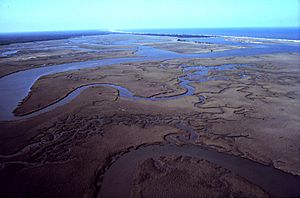Winyah Bay facts for kids
Winyah Bay is a large coastal area where several rivers meet the ocean. It's like a big mixing bowl for fresh river water and salty ocean water. This special place is located in Georgetown County, in eastern South Carolina. The bay gets its name from the Winyaw people, a Native American tribe who lived there a long time ago. The historic city of Georgetown sits right on the bay.
Winyah Bay formed because the sea level rose over many years, covering what used to be dry land. For generations, Native American groups found it a great place to fish. Later, English colonists developed the area into an important seaport. They also grew a lot of rice and harvested timber here.
The entrance to the bay is surrounded by North Island, South Island, and Cat Island. Today, most of these islands are part of the Tom Yawkey Wildlife Center. This land was given to the South Carolina Department of Natural Resources by Tom Yawkey, who used to own the Boston Red Sox baseball team.
Winyah Bay is one of the largest estuaries on the East Coast of the United States. It's home to many different animals that live in the water and on land. You might see sturgeon, sharks, dolphins, red drum fish, stingrays, white shrimp, and blue crabs. Many birds also live here, like pelicans, bald eagles, cormorants, and various types of seagulls.
Contents
Exploring Winyah Bay's Past
Early European Visitors
The first Europeans to see Winyah Bay arrived on June 21, 1521. Two ships, led by Pedro de Quejo and Francisco Gordillo, explored the area. They called the Waccamaw River the Jordan River. They named the whole area Chicora, after the local Shakori tribe. The explorers traded with the Native Americans for about a month. They also explored the coast both north and south of the bay. Sadly, they took about 60 Native Americans with them back to Santo Domingo.
One of these Native Americans was Francisco de Chicora. He traveled to Spain and shared many stories about his homeland with a historian named Peter Martyr. These stories were published in detailed reports. Pedro de Quejo returned to Winyah Bay in 1525. He explored a large part of the coast, from Amelia Island in Florida all the way to Chesapeake Bay in Maryland. His discoveries were even put on a map in 1526 by Juan Vespucci.
A New Colony and Its Challenges
On August 9, 1526, a group of about 600 colonists arrived in Winyah Bay. They were led by Lucas Vázquez de Ayllón and planned to start a new colony. Among the colonists were enslaved Africans. This was almost 100 years before enslaved Africans arrived in Virginia in 1619. Francisco de Chicora came back with this group as a translator, but he soon escaped to rejoin his family.
After about a month, Ayllón moved the colony to what is now Georgia. However, the colony did not succeed and failed within a few months. The enslaved Africans were able to escape and live with the local Native Americans. The remaining 100 colonists returned to Santo Domingo.
Images for kids



